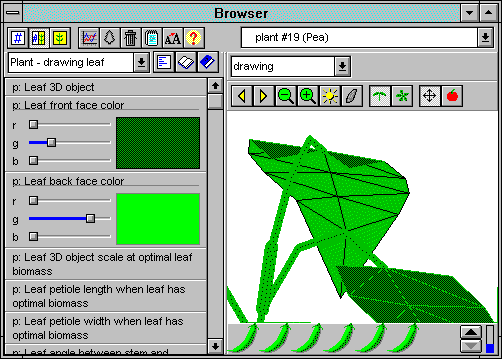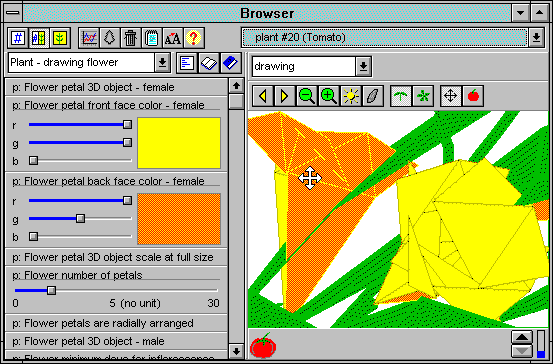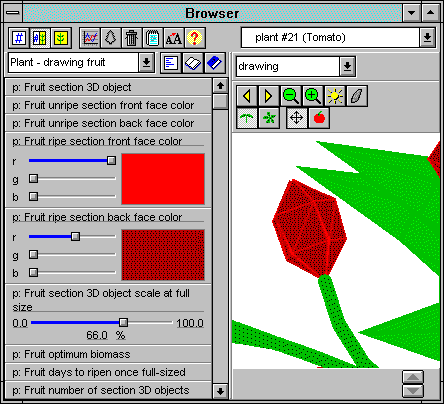Garden with Insight v1.0 Help: How to change a plant's colors
To change the colors used to draw a plant, first bring up the plant in
the browser (see How to select a plant in
the browser). Click this button  to show both the left and the right sides of the browser. to show both the left and the right sides of the browser.
On the numbers side of the browser, choose a group that includes aspects for plant
drawing, such as Plant draw leaves, from the groups drop-down list box. Find a browser component that contains a color (it will have sliders for red, green,
and blue values and a colored rectangle).

A browser component with a color
Notice that most of these color components are called "front face color" or "back face
color". Colors are used to fill in the surfaces of three-dimensional plant parts (leaves, flowers, etc.).
These plant parts are drawn using 3D objects, which are planar objects made of triangles which
describe a surface. Each 3D object has two surfaces, or faces: a front face and a back face. Front
and back faces are like the head and tail sides of a penny.
For leaves, a leaf 3D object is drawn simply as it appears in the 3D object. The front
face faces up, and the back face faces down.

A leaf showing top (front face) and bottom (back face) colors
For flowers, a petal 3D object is usually drawn several times pointing out while rotating
around a center point. This is a reasonable simulation of many flowers. The front face faces in,
and the back face faces out.

A flower showing inside (front face) and outside (back face) colors
For fruits, axillary buds, flower buds, and root tops, a
section 3D object is usually drawn several times pointing in while rotating around a center point.
Sections are like the outside walls of the sections of an orange. The front face faces in, and the
back face faces out.

A fruit showing inside (front face) and outside (back face) colors
You must specify front and back face colors for each 3D object used by the plant, and a few other
colors as well.
The colors used by the plant are:
for 3D objects:
leaves: front and back face leaf colors
seedling (first) leaves: front and back face leaf colors
axillary buds: front and back face section colors
flower buds (male and female): front and back face petal
colors
flowers (male and female): front and back face petal colors
fruit: front and back face section unripe and ripe
colors
root top: front and back face section colors
not for 3D objects:
leaves: leaf petiole color (also used for seedling leaf petioles)
internodes: front and back face color (actually the internode back face color is ignored)
inflorescences (male and female): stem color
To change a color in a color browser component, click on the colored rectangle, choose a color from the
window that appears, and click OK. Or drag one of the red, green and blue sliders to change the color.
The plant will redraw using the new color you chose. If the plant is old or N or P stressed, the colors of the leaf and internode may be different than what
you chose, because those colors are amended to show these stresses. Old leaves tend toward brown; N
stressed leaves tend toward yellow; and P stressed leaves tend toward black.
You can undo changing any color in the browser by choosing Undo from the Edit menu on the garden window.
| 
